The electrical equipment of this car is made according to a single-wire circuit: the negative terminals of the instruments and equipment are connected to the "mass" - the body and other mechanisms of the car, which play the role of a second drive. The on-board network of the Gazelle is 12V direct current. To enable electrical circuit serves as an ignition lock, which consists of a contact drive and an anti-theft lock. When the engine is not running, all electrical consumers take power from the battery, and when the engine is running, power is supplied from the alternator. While the element is working, the battery is charging, and the on-board circuit is powered through two fuses.
The lighting circuit is equipped with a 40A fuse and the circuit additional equipment and mechanisms - with a 60 A fuse. They are placed in which is installed in the engine compartment. Also, the circuits of all consumers are protected by additional fuses with a lower current operation. They are located under the dashboard on the driver's side.
Type of
The Gazelle generator is a synchronous three-phase machine with electromagnetic excitation and is designed to convert rotary motion in electrical energy. The car is equipped with models 2502.3771 or 9422.3701, the power of which is about 1000 watts. Do-it-yourself installation of the generator on the Gazelle is carried out using a mounting bracket on the right side of the power unit. It is driven by a V-belt from the crankshaft ratchet. It works in tandem with a built-in voltage regulator Ya212A11E, which keeps the output voltage in a given operating mode.
Possible malfunctions
In the event of a malfunction of the Gazelle generator, the operation of all electronic devices is disrupted, and the battery is not recharged. A special pointer on the dashboard informs the driver about the breakdown of this part. With such a malfunction, starting the engine and driving the car is still possible, but until the battery is completely discharged. It is impossible to drive in such a car in a normal way.
The main malfunctions of the generator include the following: violation of the integrity of the wires of the charging circuit, failure of the bearings, damage diode bridge, short circuit of the stator coil winding, breakdown of the voltage regulator, wear of the slip rings, excessive wear of the brushes.

The Gazelle generator, like any car mechanism, can have both mechanical and electrical damage. Therefore, the method of eliminating the breakdown, and the types of operations are of a different nature.
Mechanical damage includes wear and damage to rolling bearings, springs, violation of the integrity of the housing, pulley and drive belt.
Malfunctions that are called electrical can include a break in the stator winding, cracks and wear of brushes, breakdown of the relay-regulator, melting of the insulating coating of turns, inter-turn short circuits.
With any of these types of breakdowns, the car's generator does not fully perform its functions or completely fails, which affects the operation of all electronic devices and the engine as a whole.
Causes of malfunctions
Normal corrosion, wear and moisture can cause a variety of malfunctions. Mechanical failures often occur due to prolonged use. vehicle and fatigue of the material, the use of poor quality materials in the manufacture of the generator, non-compliance with the operating conditions of the product and violation of the normal operating mode, under the influence external factors such as dust, moisture, heat and salt.
How to remove the generator on the Gazelle?
Now consider the issue of dismantling. When carrying out repair operations on a Gazelle car, the removal of the generator must be carried out in accordance with all technological instructions and follow the safety rules during work. In the event that the car engine is hot, it is necessary to let it cool down in order to avoid the possibility of getting burned.
If there is a malfunction of the generator, it is removed from the car engine and diagnostic and repair operations are carried out. To do this, you can contact the service workshops or carry out repairs yourself. Many motorists who first encountered this problem are wondering how to change the generator to the Gazelle. The operation of removing and installing this part does not apply to complex technological and repair processes, and it can be done at home. To do this, you need a standard set of tools.
Withdrawal process
Before replacing the generator with a Gazelle, it is important to remove the negative, thereby de-energizing the car's network, and also disconnect the electrical wires from the part. Next, you need to loosen the belt tension using a special mechanism and remove it. Then, having unscrewed the two fixing bolts of the generator from the engine crankcase, we remove the generator itself from the engine compartment.
In case of failure of the brushes, it is not difficult to replace them.

It is only necessary to unscrew the two screws securing the brushes and remove them from the housing. But in case of more serious malfunctions, the element is subject to disassembly and a detailed analysis of the malfunctions.
Interchangeability
In the event that the car cannot be repaired for a long time, the original branded generator is not available, and the faulty one needs detailed repairs, it can be replaced, thus installing the VAZ generator on the Gazelle. It is able to provide the car with the necessary amount of electricity, as it has similar performance indicators.
Disassembly
This section describes a step-by-step process that will help you properly disassemble the Gazelle generator.
So, first you need to remove the plastic protective cover from the case. Then unscrew the brush block and voltage regulator, having previously disconnected the wiring from it. Next, unscrew the four tie rods of the generator housing and dismantle the housing cover together with the stator. Then, having disconnected the winding terminals from the diode bridge, you need to remove the stator, and if necessary,

You can carry out the process of diagnosing parts of the generator using measuring instruments: E236 or a special control light.
Checking the condition of parts
Regardless of which generator is installed on the Gazelle, the causes of the malfunction, as a rule, can be of the same nature.
They should not have chips and cracks, when pressed with a finger, they should sink freely into the channels of the brush holder, and under the influence of a spring return to their original position.
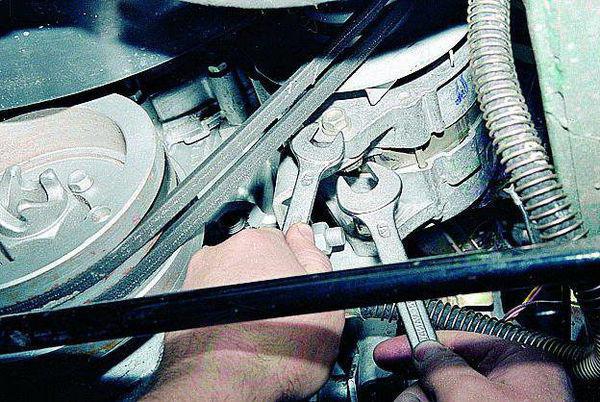
The length of the brushes should not be less than 4 mm, and in the presence of severe wear, they are replaced with new ones.
The stator is checked for the presence of a short circuit of the coil windings to the housing.
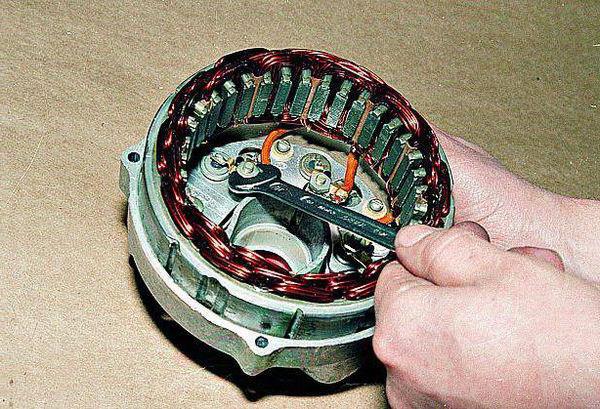
This is done by connecting one terminal of the control light to the housing, and the second is connected in turn to one of the three terminals of the turns. In this case, if there is a short circuit to the case, the control lamp will light up. Having found this type of malfunction, it is eliminated or the stator is completely replaced.
To check the stator for a short circuit between the turns, a test lamp is connected in turn to the two terminals of the windings. Moreover, if the light bulb lights up, then there is no break in the turns.
The rectifier unit of the generator should be cleaned of dust and dirt deposits. Next, check the diodes using a test lamp. Due to the fact that diodes of different polarity are placed in each section, they are checked with different polarity of the battery connection. In the event that a faulty block is found, it is replaced.
Checking the generator after repair
After a detailed inspection and replacement of defective elements, the generator is assembled. Assembly takes place in reverse order. After the Gazelle generator is assembled, it is important to diagnose. The good condition and correctness of its assembly can be determined by checking the speed, during which the generator gives out a current equal to 40 A and 70 A. Diagnostics are carried out on a special stand. The electric motor of the test stand smoothly changes the speed of the rotor. At the same time, the indicators of the generator are measured, and the degree of its serviceability is also determined.
Mounting the dynamo on the engine
Mounting on the engine is carried out in compliance with a certain technological process.

First, we unscrew the fastening nuts of the generator brackets to the crankcase. Next, install the dynamo and fix the front mounting bolt. Then we move the front bracket and achieve alignment of the crankshaft ratchet with the drive flywheel of the part and the pump drive. By moving the bracket, we achieve the elimination of the gap between the generator loop. We install the rear mounting bolt and firmly tighten the mounting nuts of the brackets to the engine crankcase. Next, we put the drive belt on the pulleys and tighten it with the tension bracket. We carry out a control check of the tightening of all threaded connections. We connect the part to the power supply of the car and put the terminals on the battery.
Therefore, to solve such a question is not difficult, and besides, the process itself takes a small amount of time. You can significantly save on the services of an auto mechanic.
Checking the generator on the car
After installing the part in place, you need to start the car engine. Next, you need to turn on the maximum number of electrical appliances available in your vehicle (cabin heater fan, wipers, car radio, interior lighting) and turn on the headlights. At the same time, even at idle engine speed, the voltage in the on-board network should be 13.8 V. With this indicator, the operation of the car will not cause any problems.
So, we figured out how to change the generator to the Gazelle.
On any car, the generator performs two important functions - it provides all consumers with the necessary electricity, it recharges the battery. The Gazelle generator generates electricity alternating current, a constant pressure required for the on-board network is achieved using a rectifier.
A lot depends on the performance of the energy source - it is impossible to operate a car with a faulty generator.
Gazelle generator circuit
The generator on Gazelle cars is a synchronous three-phase electric machine, in the excitation windings of which electricity. The rotor (armature) rotates in the housing and is inside a constant magnetic field, which is created by the stator (winding). Electricity is generated here as follows:
- with the start of the engine from the crankshaft through the drive belt, the movement is transmitted to the pulley of the generator set;
- together with the pulley, the rotor begins to rotate, a magnetic field arises between the stator and armature windings;
- due to electromagnetic induction, an EMF is generated, an alternating current appears;
- a diode bridge, consisting of diodes of different polarity, rectifies the electric current, making it constant;
- then the current from the rotor collector is transferred to the brushes and fed to the relay-regulator;
- the regulator limits the voltage, ensuring the safe operation of consumers.
The Gazelle generator circuit is very simple, the assembly consists of the following parts:
- case, it is made of two halves - aluminum front and rear covers;
- fixed winding - stator;
- rotating shaft - rotor (anchor);
- pulley and impeller;
- diode (rectifier) bridge;
- two bearings on which the armature rotates;
- brush assembly;
- relay-regulator (voltage regulator).
It should be noted that the voltage regulator is not located directly on the generator on all Gazelle models; on vehicles with a ZMZ-402 engine, the relay-regulator can be mounted on the side member. 
Types of generators "Gazelle"
The type of generator installed on Gazelle commercial vehicles depends on the engine model - the first GAZ-3302 vehicles had two types of engines:
- ZMZ-402;
- ZMZ-4063.
On the second generation of Gazelles, ZMZ-405 and Chrysler 2.4 engines began to be installed, Gazelle Business cars, produced since 2010, are equipped with UMZ-4216 and Cummins engines, respectively, other types of generator devices are installed on them.
Generators are different in power, and are able to produce a different current. The standard current source is calculated with a small power margin, but the additional power consumption is not taken into account here. Additional energy consumers can be:
- power windows;
- electrical antenna:
- audio system;
- air conditioner;
- additional cooling fan in the cabin;
- additional oven motor.
If the alternator turns out to be weak, it will not be enough to charge, as a result, the battery may be discharged. Therefore, in many cases, the owners of the Gazelle try to install a more powerful current source - the car will not suffer from the power reserve. For a gazelle, there are generators that generate a current of 65/75/90/100/115/120/135 Amperes. There is a misconception - if the power of the generator device is large, the electrolyte in the battery may boil. But this is not true - the generator produces current depending on the load, and the excess voltage is limited by the relay-regulator. A powerful generator has only two drawbacks:
- such electrical machine higher price;
- the overall unit may not always fit in size.
The generator, like any other part in the car, tends to break down, there are several types of malfunctions:
- charging is completely lost;
- there is an "undercharge";
- there is a large voltage in the network (more than 14.7 volts);
- the generator starts making noise.
There can be several reasons for the noise:
- worn or defective bearings;
- the drive belt has defects;
- the belt tension is weak, and therefore a whistle occurs;
- the impeller touches the belt or generator housing;
- pulley damaged;
- loosened the generator bracket.
If the voltage in the vehicle's on-board network is higher than the permissible norm, there is only one cause of the malfunction - the regulator relay has failed. For the same reason, there may be an undercharge - the voltage regulator does not cope with its functions.
If there is not enough charging, or it is completely absent, there may be several reasons for such problems:
- worn out brushes in the brush assembly;
- there are breaks or short circuits in the armature winding;
- the same defects are present in the stator winding;
- faulty diode bridge.
On a Gazelle car, the generator can be repaired quite easily, but if there are too many defects in it (for example, the rotor and stator are faulty at the same time), it is easier to buy a new unit and change it. 
Alternator belt Gazelle
On Gazelle cars, the generator belt drives the generator, thereby ensuring the rotation of the rotor, due to which the electric current necessary for the on-board network is generated. Various engine models are available different types and belt sizes:
- ZMZ-402 - toothed or smooth multi-ribbed belt, size - 10x1030 mm;
- UMZ-4216 - the same type as on the ZMZ-402 motor, size - 13x1040;
- ZMZ-406 (405) with power steering - multi-ribbed type, length - 1420 mm;
- ZMZ-406 (405) without power steering - multi-strand type, 1220 mm;
- Chrysler - poly-V type, 1750 mm;
- Cummins 2.8 - multi-strand type, 1226 mm.
Depending on the engine model and manufacturer, alternator belts can be different in price, they wear out over time and must be replaced. Since the belt drive still ensures the rotation of the water pump, if the generator belt is too tight, the noise of the pump bearings and the generator itself appears. You can’t do a very weak stretch either:
- charging is lost;
- the water pump pumps weakly, respectively, the engine starts to overheat;
- there is a very unpleasant whistle of the belt.
For Gazelle and Sobol cars, generators are produced by different manufacturers, the most famous companies are:
- ELDIX (Bulgaria);
- PRAMO-ISKRA (city of Rzhev);
- KZATE (old name KATEK, Samara);
- BATE (Belarus).
In 2016, generators for GAZ commercial vehicles cost on average from 4,000 to 9,000 rubles, the cost of a unit largely depends on the manufacturer, engine model and the power of the generator itself. The most expensive are Cummins turbodiesel parts, prices for spare parts range from 8 to 15 thousand rubles, the most expensive are parts of original production. The ZMZ-402 generator manufactured by KZATE for 65 Amperes is relatively inexpensive - an average of 4.5-5 thousand rubles. 
Generator replacement
The entire generator unit on the car is changed in the following cases:
- if many parts in the device require replacement, and repair of the unit is not economically viable, it is easier and cheaper to buy a new generator;
- you need to urgently go on a flight, and there is no time to do repairs;
- a new generator is installed, and the old one is repaired and removed in reserve - it is a backup.
The complexity of replacing the generator unit also depends on the engine model, but on any engine, work is done quickly enough, since it is still simple on all brands of Gazelle cars. The easiest way is to replace the generator with a car with a 402 engine, we do the work as follows;
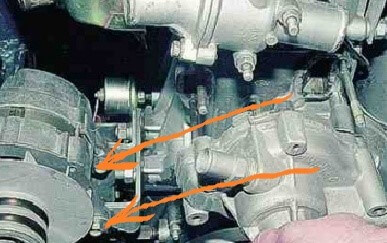
- after the belt has been tensioned, we fasten the bolts with nuts to the end - they are now under the generator, and getting to them is already somewhat more difficult.
To fix the generator securely, it is necessary to install two nuts on the bolts, and be sure to lay between the bolt and the nut along the engraver - on the ZMZ-402 motors (however, as well as on the UMZ-4216), vibration fasteners tend to unscrew.
If the bearings in the generator wear out, noise (hum) appears in the generator unit. It is possible to drive with such noise for some time, but it is undesirable, and it is impossible to delay the repair for a long time - the bearings can jam and burn out. Bearings are always changed on a removed generator, and in order to replace it, the generator unit must be disassembled. Similar work can be done independently, but it should be borne in mind that the bearings are pressed in, and a special puller is required to dismantle them. The rear bearing is rigidly pressed onto the rotor shaft, and it is almost impossible to do without a puller. 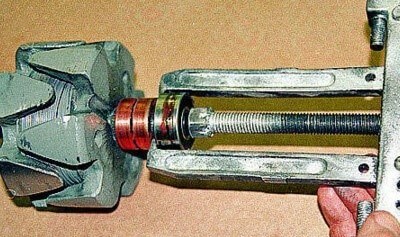
In some cases, the bearing boils tightly in the front cover of the housing, and in this case it is easier to replace it as an assembly with the cover.
Page 1 of 3
How to check and replace the brushes of the generator and voltage regulator of a Gazelle car
Checking and replacing brushes and a voltage regulator on cars with an engine of the ZMZ-405, ZMZ-406 type
Generators 9422.3701 or 5122.3771 with built-in integrated voltage regulators are installed on engines of the ZMZ-406 and ZMZ-405 families.
In order to make sure that the voltage regulator is malfunctioning, we turn off all consumers except for the side light and measure the voltage at 1000 ... 1200 min -1, which should be in the range of 13.5 ... 14.2 V.
Connect a 12 V test lamp to the brushes.
Apply a voltage of 12 V "+" to the terminal, and "-" to the "mass" of the brush holder.
In this case, the control lamp should light up.
If the control lamp does not light up, the voltage regulator must be replaced.
The voltage regulator is made in a single housing with a brush holder.
Disconnect the battery.
We disconnect the wires from the generator terminals, remove the plug from the generator plug terminal.
|
|
|
|
|
The initial quick test of the alternator can be performed directly on the vehicle.
Checking the generator on vehicles with a ZMZ-402 engine
On cars with engines ZMZ-4025 and ZMZ-4026, generators 16.3701 or 191.3701 are installed, which are not equipped with a built-in voltage regulator. These generators work in conjunction with a remote transistor voltage regulator type 13.3702-01 or 50.3702, which has electronic protection against short circuit in the excitation circuit of the generator.
The work is more convenient to do together.
We start the engine, let it run for several minutes, then, pressing the "gas" pedal, we bring the crankshaft speed to 3000 min -1. We turn on consumers: high beam headlights; heater fan; wiper; alarm. In this mode, we measure the voltage at the battery terminals, which should be above 12 V. If this is not the case, the generator windings are faulty (open or short circuit), the voltage regulator with the brush assembly, the slip rings are oxidized or oily, the brushes are worn out or “hung”. In order to make sure that the voltage regulator is malfunctioning, we turn off all consumers except for the side light and measure the voltage at a speed of 1000 ... 1200 min -1, which should be in the range of 13.8 ... 14.5 V.
2. We attach a voltmeter or a test lamp to the output “W” of the block, and to the body of the voltage regulator. Turn on the ignition
If there is no voltage (the lamp is off), one of the following malfunctions is possible: a violation of the contact of the excitation winding with slip rings; breakage of the excitation winding; “hanging” of brushes in the channels of the brush holder; burning, oxidation and severe wear of the slip rings of the rotor.
Checking the generator on vehicles with an engine such as ZMZ-405, ZMZ-406
Generators 9422.3701 or 5122.3771 with built-in integrated voltage regulators are installed on engines of the ZMZ-406 and ZMZ-405 families.
We start the engine, let it run for several minutes, then, pressing the "gas" pedal, we bring the crankshaft speed to 3000 min -1. We turn on consumers: high beam headlights; heater fan; wiper; alarm. We measure the voltage at the battery terminals, which should be higher than 12 V. If this is not the case, the generator windings are faulty (open or short circuit), the voltage regulator with the brush assembly, the excitation winding rings are oxidized or oiled, the brushes are worn out or “hung”.
In order to make sure that the voltage regulator is malfunctioning, we turn off all consumers except for the side light and measure the voltage at 1000 ... 1200 min -1, which should be in the range of 13.5 ... 14.2 V.
The removed voltage regulator can be checked as follows. We connect a lamp between the brushes (21 ... 35 W, 12 V). We connect +12 V to the “D” terminal, and “minus” to the “ground” terminal. At the same time, the lamp should burn, and when the source voltage rises in the range of 13.5–14.2 V, it should go out. If the lamp is on in both cases, replace the regulator.
Checking the diodes of the rectifier unit and additional diodes, see " Removing and repairing the generator". In case of failure of its elements, we recommend replacing the rectifier unit as an assembly. It is allowed to replace individual diodes, however, they will need to be repressed into a holder - an operation that requires accuracy and skill.
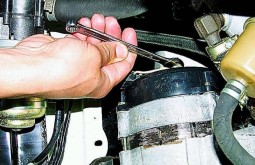 1. With the “10” key, unscrew the nut
1. With the “10” key, unscrew the nut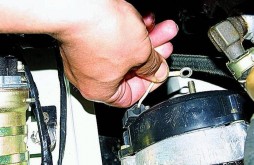 2. Remove the lugs of the capacitor wire from the “+” terminal of the generator.
2. Remove the lugs of the capacitor wire from the “+” terminal of the generator.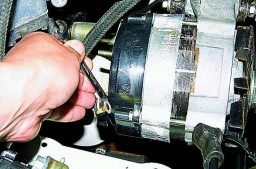 3. Using the “8” key, unscrew the condenser fastening nut
3. Using the “8” key, unscrew the condenser fastening nut




